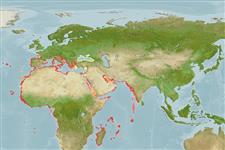Preferred temperature (Ref.
115969): 16.2 - 29, mean 26.3 (based on 478 cells).
Phylogenetic diversity index (Ref.
82804): PD
50 = 1.0000 [Uniqueness, from 0.5 = low to 2.0 = high].
Bayesian length-weight: a=0.01349 (0.00996 - 0.01827), b=2.94 (2.85 - 3.03), in cm Total Length, based on LWR estimates for this species (Ref.
93245).
مستوى غذائي (Ref.
69278): 4.5 ±0.8 se; based on diet studies.
المرونه (Ref.
120179): وسيط, الحد الزمني الأدني لتضاعف عدد أفراد المجتمع 1.4-4.4 سنة (Assuming tm=2).
Prior r = 0.51, 95% CL = 0.34 - 0.76, Based on 1 data-limited stock assessment.
Fishing Vulnerability (Ref.
59153): Very high vulnerability (90 of 100).
Climate Vulnerability (Ref.
125649): High vulnerability (57 of 100).
